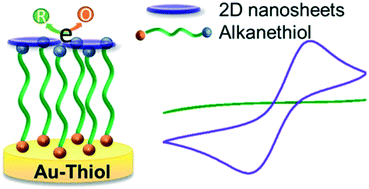The influence of 2D nanomaterials on electron transfer across molecular thin films
Abstract
Here we report the design and formation of electron transfer pathways across self-assembled monolayers (SAMs) after attachment of BN-NH2 and MoS2 nanosheets through hydrophobic interaction. The gold electrodes were firstly passivated with methyl group terminated alkanethiols with different carbon chain lengths (n = 4, 6, 8 and 11), followed by the attachment of 2D nanomaterials including boron nitride and MoS2 nanosheets via hydrophobic interaction. We identified the significant influence of 2D nanomaterials on electron transfer across SAM-modified gold electrodes.

- This article is part of the themed collection: Soft Materials Nanoarchitectonics


 Please wait while we load your content...
Please wait while we load your content...